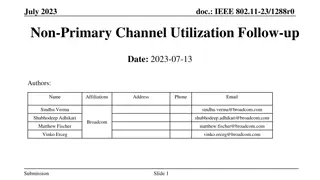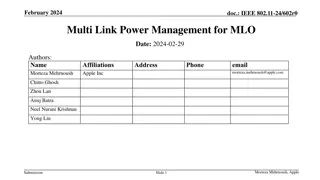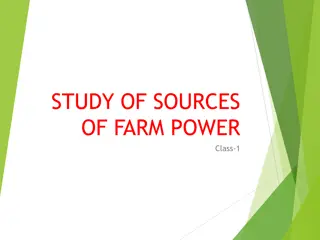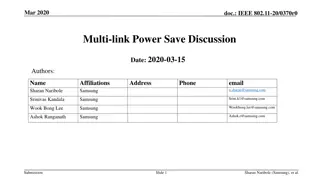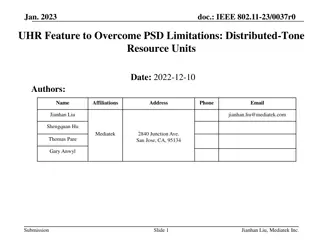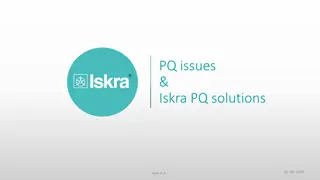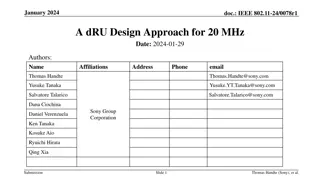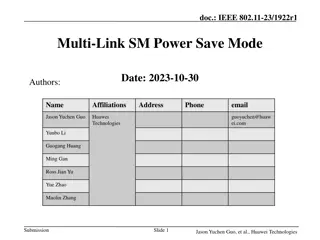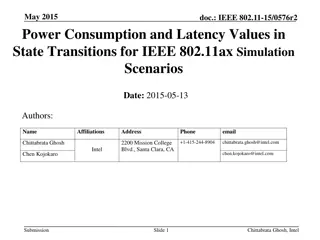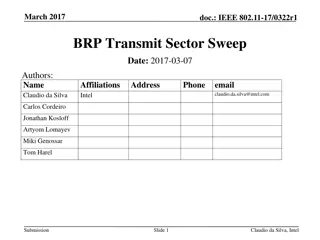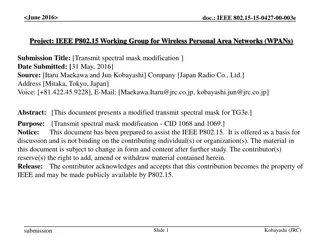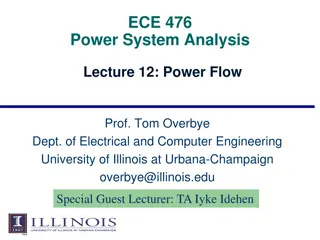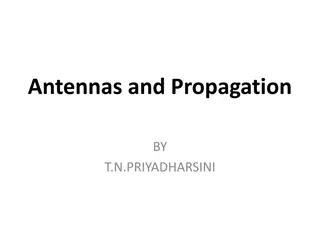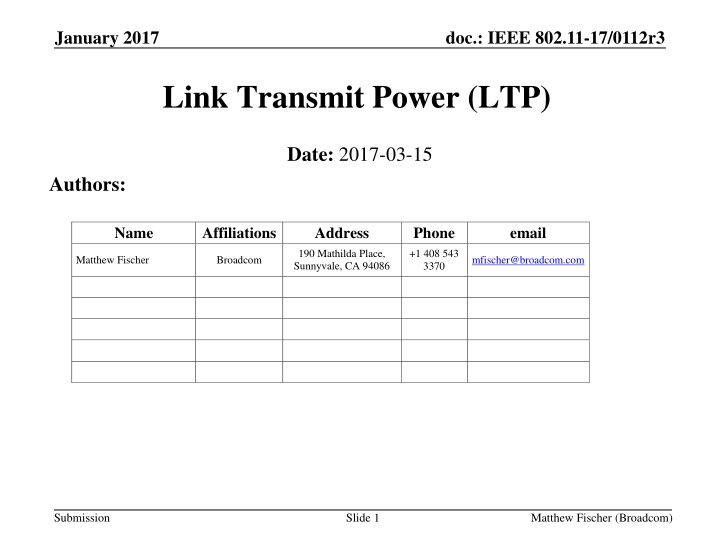
Enhancing Link Transmit Power for Improved Performance
Enhance transmitter power adjustment for better performance in IEEE 802.11 networks. The proposal focuses on increasing power for higher MCS use and reducing power for spatial reuse benefits.
Download Presentation

Please find below an Image/Link to download the presentation.
The content on the website is provided AS IS for your information and personal use only. It may not be sold, licensed, or shared on other websites without obtaining consent from the author. If you encounter any issues during the download, it is possible that the publisher has removed the file from their server.
You are allowed to download the files provided on this website for personal or commercial use, subject to the condition that they are used lawfully. All files are the property of their respective owners.
The content on the website is provided AS IS for your information and personal use only. It may not be sold, licensed, or shared on other websites without obtaining consent from the author.
E N D
Presentation Transcript
January 2017 doc.: IEEE 802.11-17/0112r3 Link Transmit Power (LTP) Date: 2017-03-15 Authors: Name Affiliations Address Phone email 190 Mathilda Place, Sunnyvale, CA 94086 +1 408 543 3370 Matthew Fischer Broadcom mfischer@broadcom.com Submission Slide 1 Matthew Fischer (Broadcom)
January 2017 doc.: IEEE 802.11-17/0112r3 Abstract Transceivers can benefit from increased EVM when compared to EVM requirements in the spec Due to Tx Beamforming, delay spread, Doppler, receiver design, etc. Existing EVM spec targeted to SISO, CDD We show both simulation results and measurement data to justify our proposal Propose to provide means for TX Power modification per link Per request of the recipient and approval of the transmitter Signaling through elements and management frames Link Transmit Power signaling mechanism creates benefits: Increase in TX Power per MCS to allow higher MCS use Reduction in TX Power to aid in system wide spatial reuse Submission Slide 2 Matthew Fischer (Broadcom)
January 2017 doc.: IEEE 802.11-17/0112r3 CID 8098 Add a mechanism to set the transmit power per direction per link in order to achieve an increase in performance due to improved receiver design since the original EVM specification was written. Add a mechanism to set the transmit power per direction per link in order to achieve an increase in performance due to improved receiver design since the original EVM specification was written. Expect a submission detailing some changes. Submission Slide 3 Matthew Fischer (Broadcom)
January 2017 doc.: IEEE 802.11-17/0112r3 Rationale Reasons to expect that EVM can be increased over EVM in the spec: LDPC requires less stringent EVM requirements TX EVM varies over operating condition, but TX PA set for worst case Beamforming (NTX > NSS) accommodates relaxed EVM TX Power is typically conservative due to implementation variance and measurement precision, ~1.5 dB Channel delay spread is not known at transmitter Doppler is not known at transmitter TX EVM defined in standard was low bar for receiver design expectations a few years ago Modern receivers can typically handle increased EVM due to LDPC, etc. Additional receiver design improvements are likely in the future TX EVM defined in standard was based on SISO, CDD Submission Slide 4 Matthew Fischer (Broadcom)
January 2017 doc.: IEEE 802.11-17/0112r3 LTP Additional Use Link Transmit Power signaling mechanism allows: Increase in TX Power per MCS to allow higher MCS use Reduction in TX Power to aid in system wide spatial reuse Submission Slide 5 Matthew Fischer (Broadcom)
January 2017 doc.: IEEE 802.11-17/0112r3 Transmitter Self Adjustment Transmitter may be able to make TX power adjustments to account for: Precoding Scenario (8x2, 4x2, 2x2, using beamforming or spatial expansion) PA characteristic, e.g. non-linearity However, transmitter may not be aware of channel (Doppler and Delay Spread) and receiver characteristics Receiver can measure channel effect and request power increase or decrease to optimize link and system gain We simulate possible gains as a result of EVM requirement modification Submission Slide 6 Matthew Fischer (Broadcom)
January 2017 doc.: IEEE 802.11-17/0112r3 Receiver Based Adjustment Receiver determines amount of adjustment and signals to transmitter to modify PA backoff through LTP Receiver method for determination of adjustment: Make adjustment table through a-priori simulations such as shown in this presentation Transmitter always starts a new link with TX power table set according to specified EVM Trial and error suggest modifications and measure the result Use receiver-side estimation of EVM Submission Slide 7 Matthew Fischer (Broadcom)
January 2017 doc.: IEEE 802.11-17/0112r3 Simulation Conditions, Gain Metric PA simulated is lab measured Skyworks PA (SKY85302-11) Using Channel B NLOS 80MHz, and D NLOS 80MHz For Nss=2: scenarios are Precoding NTX=4 x NRX=2 and NTX=8 x NRX=2. Reference scenario is NTX=2 x NRX=2 MIMO with direct mapping. For Nss=1: scenarios are Precoding NTX=4 x NRX=2 and NTX=8 x NRX=2. Reference scenario is CDD with NTX=4 x NRX=2, Nss=1 For each scenario NTX x NRX we mark the OBO at which transmit distortion increases required SNR (for 10% PER) by 1dB from ideal This OBO is considered a conservative OBO at which the link should operate The difference between OBO of precoded (4x2 or 8x2) link and the 2x2 link is considered as the LTP gain we could achieve by letting receiver request transmit power. Submission Slide 8 Matthew Fischer (Broadcom)
January 2017 doc.: IEEE 802.11-17/0112r3 Simulation Results For each MCS we plot SNR thresh (i.e. required for 10% PER with 1.7KB packets) as function of OBO EVM as function of OBO (green curve) EVM was computed and plotted for 2x2 MIMO case, Nss=2, using direct mapping (measurement described in IEEE Std 802.11-2016 21.3.17.4.3) Allowed relative constellation error (EVM Spec) is also marked Precoder is normalized to have same power for all antennas, thus precoded signal also obeys same OBO to EVM (green) curve OBO setting marked by diamond, is the OBO maximizing system gain (min Psat/N0=min OBO+SNR). This shows similar LTP gain as the 1dB loss point. Submission Slide 9 Matthew Fischer (Broadcom)
January 2017 doc.: IEEE 802.11-17/0112r3 Channel D, BW=80MHz, Nss=2 SVDBF, MCS11 Showing RX SNR required (for 10% PER), as function of output backoff (OBO) Channel, D 80MHz, NLOS Nss=2, MCS11, ML Decoder Green curve shows SISO per TX ant EVM as function of OBO Comparing OBO at which 1dB SNR margin is lost for each case 2x2, Used as reference case 4x2 50DDP Gain=2.6 dB 4x2 0DDP Gain=3.3 dB 8x2 50DDP Gain=4.2 dB 8x2 0DDP Gain=4.5 dB Submission Slide 10 Matthew Fischer (Broadcom)
January 2017 doc.: IEEE 802.11-17/0112r3 Channel D, BW=80MHz, Nss=2 SVDBF, MCS11 D2x2 EVM measured per TX antenna 1dB loss EVM Spec D4x2 50DDP 1dB loss D4x2 0DDP D8x2 25DDP D8x2 0DDP Submission Slide 11 Matthew Fischer (Broadcom)
January 2017 doc.: IEEE 802.11-17/0112r3 Channel D, BW=80MHz, Nss=2 SVDBF, MCS7 Showing RX SNR required (for 10% PER), as function of output backoff (OBO) Channel, D 80MHz, NLOS Nss=2, MCS7, ML Decoder Comparing OBO at which 1dB SNR margin is lost for each case 2x2, Used as reference case 4x2 50DDP Gain= 2.3 dB 4x2 0DDP Gain= 3.7 dB 8x2 50DDP Gain= 4.1 dB 8x2 0DDP Gain= 4.8 dB Submission Slide 12 Matthew Fischer (Broadcom)
January 2017 doc.: IEEE 802.11-17/0112r3 Channel D, BW=80MHz, Nss=2 SVDBF, MCS7 EVM measured EVM Spec D2x2 1dB loss D4x2 50DDP 1dB loss 1dB loss D4x2 0DDP D8x2 50DDP D8x2 0DDP Submission Slide 13 Matthew Fischer (Broadcom)
January 2017 doc.: IEEE 802.11-17/0112r3 Channel B, BW=80MHz, Nss=2 SVDBF, MCS7 Showing RX SNR required (for 10% PER), as function of output backoff (OBO) Channel, B 80MHz, NLOS Nss=2, MCS7, ML Decoder Comparing OBO at which 1dB SNR margin is lost for each case 2x2, Used as reference case 4x2 50DDP Gain= 2.4 dB 4x2 0DDP Gain= 3.4 dB 8x2 50DDP Gain= 3.6 dB 8x2 0DDP Gain= 4.3 dB Submission Slide 14 Matthew Fischer (Broadcom)
January 2017 doc.: IEEE 802.11-17/0112r3 Channel B, BW=80MHz, Nss=2 SVDBF, MCS7 EVM measured D2x2 EVM Spec 1dB loss D4x2 50DDP 1dB loss D4x2 0DDP 1dB loss D8x2 25DDP D8x2 0DDP Submission Slide 15 Matthew Fischer (Broadcom)
January 2017 doc.: IEEE 802.11-17/0112r3 Measured Lab Results Submission Slide 16 Matthew Fischer (Broadcom)
January 2017 doc.: IEEE 802.11-17/0112r3 System setup for PA OBO (Output Back Off) gain measurements with real devices and channel emulator EB channel emulator with channel model BNLOS/DNLOS AP:BRCM + iperf Client:BRCM + iperf Submission Slide 17 Matthew Fischer (Broadcom)
January 2017 doc.: IEEE 802.11-17/0112r3 PA OBO gain results with real devices and channel emulator: BF(Beam forming) vs. CDD With 4x2 Tx BF, the maximum link budget is achieved at Tx EVM of - 20.2dB, which is 4.8dB worse than the standard requirement (mcs=6). Compared to CDD mode, BF has 2dB higher transmit power at the maximum link budget (e.g. OBO gain). Channel D NLOS MCS NTX NRX NSS OBO Gain Tx EVM 6 9 7 4 4 4 2 2 2 1 1 2 2.0 dB 2.0 dB 2.0 dB 20.18 dB 27.7 dB 24.7 dB Note: OBO gain is calculated as the difference of Tx powers at the maximum link budget between BF and CDD modes. Tx EVM is the Tx EVM at the Tx power where the maximum link budget is achieved with BF. Submission Slide 18 Matthew Fischer (Broadcom)
January 2017 doc.: IEEE 802.11-17/0112r3 Link budget comparison between LAB measurements and C simulations LAB measurements and simulation results correlate well. With 4x2 Tx BF, the maximum link budget is achieved at Tx EVM of -20.2dB, which is 4.8dB worse than the standard requirement of -25.0dB (mcs=6). Compared to CDD mode, BF has ~2dB higher Tx power at the maximum link budget (OBO gain). Optimal Tx power in BF mode is ~2dB higher than the Tx EVM limited Tx power. Submission Slide 19 Matthew Fischer (Broadcom)
January 2017 doc.: IEEE 802.11-17/0112r3 Link budget comparison between LAB measurements and C simulations Submission Slide 20 Matthew Fischer (Broadcom)
January 2017 doc.: IEEE 802.11-17/0112r3 1dB loss point Submission Slide 21 Matthew Fischer (Broadcom)
January 2017 doc.: IEEE 802.11-17/0112r3 Proposed Draft Changes Link Transmit Power Submission Slide 22 Matthew Fischer (Broadcom)
January 2017 doc.: IEEE 802.11-17/0112r3 LTP Signaling Add capability of a receiver to request transmitter power per MCS for this link Within regulatory limits Not to affect transmitter power on other links with the same STA Hence, Link Transmit Power A STA requests a higher power per MCS at its own estimate/risk LTP requester Power can be re-adjusted at any time Per new request from LTP requester Per LTP responder initiative accompanied by unsolicited LTP response to inform LTP requester of the change Use a new LTP Request / LTP Response exchange Submission Slide 23 Matthew Fischer (Broadcom)
January 2017 doc.: IEEE 802.11-17/0112r3 Add a capability indication Extended Capability information element (IE) Existing location for dot11 type-independent features E.g. this feature can be used by any letter designation E.g. 11n, 11ac, 11ax, 11afuture Link Transmit Power capability bit Not clear that this bit is really needed No reason why a STA could not send the new element to anyone and if they do not recognize it, they do nothing If they do recognize it, they could still refuse to cooperate If they do recognize it, they will respond Submission Slide 24 Matthew Fischer (Broadcom)
January 2017 doc.: IEEE 802.11-17/0112r3 Add an information element Link Transmit Power (LTP) information element Used to communicate request from receiver to transmitter Increase/decrease TX Power per MCS New element can be included in various management frames Most likely a new Public or Protected Dual of Public Action No response required (other than ACK) Transmitter either complies with request or does not comply If Transmitter makes changes, then it must inform the receiver by sending an LTP element as a response Submission Slide 25 Matthew Fischer (Broadcom)
January 2017 doc.: IEEE 802.11-17/0112r3 Add a management action frame Add to Public and Protected Dual of Public To avoid type-specific categories Submission Slide 26 Matthew Fischer (Broadcom)
January 2017 doc.: IEEE 802.11-17/0112r3 LTP Requester Behavior STA which transmits an LTP IE request Does not know exactly how much change in EVM might result at a given MCS for a given amount of TX power change Estimate is possible if LTP requester sees transmissions from LTP responder at various MCS and power combinations to allow it to make measurements Otherwise, LTP requester might have to try a few times to find a comfortable value Desirable to include a test frame NDP included in specific exchanges (see later slides) If LTP request is not accepted, then no new request allowed for X ms Submission Slide 27 Matthew Fischer (Broadcom)
January 2017 doc.: IEEE 802.11-17/0112r3 LTP Responder Behavior (1) LTP responder (LTP IE recipient) can choose to use or ignore the LTP IE information LTP responder might not be able to raise TX power it might already be at the regulatory or TPC limit LTP responder might not desire to raise TX power in order to manage spectrum E.g. cooperative arrangement with neighbors for spatial reuse/interference management E.g. in a managed environment If LTP responder chooses to change transmit power, it must inform the LTP requester (LTP IE sender) Sends an LTP response if raising or lowering TX power Submission Slide 28 Matthew Fischer (Broadcom)
January 2017 doc.: IEEE 802.11-17/0112r3 LTP Responder Behavior (2) TX EVM excursions limited to DATA-bearing frames TX EVM excursions not allowed for CTRL subtypes Transmitted in non_HT format e.g. RTS, CTS, BA, ACK Submission Slide 29 Matthew Fischer (Broadcom)
January 2017 doc.: IEEE 802.11-17/0112r3 Proposed Changes Summary (1) Add a capability bit Extended Capability IE preferred location for generic features Add a new LTP IE To carry a list of requested or used PABOMCSn values Allow the LTP IE to be transmitted within various management frames E.g. Association Request, Association Response, Action, etc Add a new Management Action frame To allow post-association requests/changes to be communicated No requirement for recipient to obey the request But LTP responder must inform LTP requester if LTP responder makes any TX power changes, requested or self-initiated Slide 30 Submission Matthew Fischer (Broadcom)
January 2017 doc.: IEEE 802.11-17/0112r3 Proposed Changes Summary (2) Change TX EVM rules Allow transmitter to exceed TX EVM requirements when LTP requester sends LTP request that would cause EVM limits to be violated LTP requester is specifically indicating that it has no problem with the expected increase in EVM No change to other TX power related rules Jurisdictional regulatory limits still apply TPC limits still apply AP self-imposed limits apply Recommend addition of test frame transmissions E.g. NDP before Beacons Submission Slide 31 Matthew Fischer (Broadcom)
January 2017 doc.: IEEE 802.11-17/0112r3 Straw poll #1 Do you support the concept of Link Transmit Power as outlined in the previous slides, without the requirement to send an NDP? Y N A Submission Slide 32 Matthew Fischer (Broadcom)
January 2017 doc.: IEEE 802.11-17/0112r3 Straw poll #2 Do you support the requirement that an NDP is transmitted by an LTP as outlined in the previous slides? Y N A Submission Slide 33 Matthew Fischer (Broadcom)
January 2017 doc.: IEEE 802.11-17/0112r3 Straw poll #3 Do you support to resolve CID 8098 by adopting the text of 11-17-0123-00-00ax-Link-Transmit-Power- Text? Y N A Submission Slide 34 Matthew Fischer (Broadcom)
January 2017 doc.: IEEE 802.11-17/0112r3 Straw Poll PHY #1 Do you support the concept of allowing a transmitter, per request of a receiver, to violate existing TX EVM by increasing the TX Power for transmissions to that requester? Y N A Submission Slide 35 Matthew Fischer (Broadcom)
January 2017 doc.: IEEE 802.11-17/0112r3 Annex 1 Link Transmit Power Specific Proposed Changes Submission Slide 36 Matthew Fischer (Broadcom)
January 2017 doc.: IEEE 802.11-17/0112r3 Ext Cap IE: add a capability indication Extended Capability information element (IE) Link Transmit Power capability bit Ext Cap IE is the location for dot11 type-independent features i.e. this feature can be used by any letter designation E.g. 11n, 11ac, 11ax, 11future Set by AP and by non-AP STA that support LTP Acts as implicit NDP request See next slide Submission Slide 37 Matthew Fischer (Broadcom)
January 2017 doc.: IEEE 802.11-17/0112r3 Implicit NDP Request When Ext Cap LTP bit is set by an AP AP should transmit NDP, SIFS before each DTIM Beacon Using TX Power indicated in the Beacon E.g. TPC Report, Power Capability, LTP IE NDP transmitted using all TX antennas When Ext Cap LTP bit is set by non-AP STA and AP also has the bit set Non-AP STA should transmit an NDP SIFS following the ACK of its Association Request transmission Using TX Power indicated in the Association Request E.g. TPC Report, Power Capability, LTP IE NDP transmitted using all TX antennas Submission Slide 38 Matthew Fischer (Broadcom)
January 2017 doc.: IEEE 802.11-17/0112r3 Add an information element Link Transmit Power (LTP) information element Used to communicate request from receiver to transmitter Used to communicate actual values from transmitter to receiver New element can be included in various management frames Public Action and Protected Dual of Public Action New Public Action LTP (Re)Association request, (Re)Association response, Beacon, Probe Response LTP Response is only required when changing PA Backoff (PABO) values In response to LTP Request and when unilaterally changing PABO values Submission Slide 39 Matthew Fischer (Broadcom)
January 2017 doc.: IEEE 802.11-17/0112r3 Link Transmit Power Parameters Link Transmit Power IE contents: Transmit power suggestion or report per MCS Value of dB [-23, 40.5] Transmitting STA can provide as many or as few constellation/coding combinations as it desires per request Transmitting STA can change values as frequently as it desires Receiving STA can use the information or ignore it Submission Slide 40 Matthew Fischer (Broadcom)
January 2017 doc.: IEEE 802.11-17/0112r3 LTP IE Format Element ID (= 255) Element Length Element ID Extension (=<ANA>) LTP Control LTP Information Octets: 1 1 1 4 variable Uses Element ID Extension Element ID = 255 Element ID Extension assigned by ANA Link Transmit Power Information field contents: Series of one-octet transmit power values One octet per Constellation/encoding (i.e. one per MCI) MCI = MCS Index Not necessary to include an octet for every constellation/encoding value Submission Slide 41 Matthew Fischer (Broadcom)
January 2017 doc.: IEEE 802.11-17/0112r3 LTP control field B0 B1 B15 B16 B17 B18 B20 B21 B22 B23 B24 B31 Transmit Power 8 LTP Report 1 LTP MCI Bitmap 15 TXBF Present 1 NTXBF Present 1 Supported Modes 3 Absolute Reserved Bits: 1 2 LTP Report LTP Report = 0 indicates a request for the LTP responder to modify TX Power settings according to the accompanying LTP Information LTP Report = 1 indicates employed values at the LTP responder LTP MCI Bitmap Bitmap of MCI (MCS Index) values, e.g. Value of 1 in bit position B3 means MCI value 2 transmit power information field is present Value of 0 in bit position B3 means MCI value 2 transmit power information field is absent TXBF Present, NTXBF Present Indicates if MCI power values are present for TXBF case, Non TXBF case entries are in MCI pairs when both are present Supported Modes Bitmap of SU, OFDMA (non-MU MIMO), Reserved, when the LTP is a request Reserved when the LTP is a Report Reserved -> requested MCS, Ntx for LTP response Alternative = copy the request LTP PPDU parameters, except for NTX Absolute Indicates if MCI TX Power field encoding represents Absolute dBm or Relative dBm (see later slide) Transmit Power Same as the field in the TCP Report IE Submission Slide 42 Matthew Fischer (Broadcom)
January 2017 doc.: IEEE 802.11-17/0112r3 MCI Encoding MCI Value Constellation, Encoding 0 BPSK, , DCM 1 BPSK, 2 QPSK 3 QPSK 4 16QAM 5 16 QAM 6 64QAM 2/3 7 64 QAM 8 64 QAM 5/6 9 256 QAM 10 256 QAM 5/6 11 1024 QAM 12 1024 QAM 5/6 13 14 Reserved Independent of BW Submission Slide 43 Matthew Fischer (Broadcom)
January 2017 doc.: IEEE 802.11-17/0112r3 LTP Information field B0 MCI TX Power 7 B6 B7 Reserved 1 Bits: LTP Power Entry field LTP Information field contains 0 or more octets Each octet is an LTP Power Entry field One octet per constellation/encoding-transmit power pair As many octets present as needed, as indicated in the LTP MCI Bitmap MCI TX Power See next slide Submission Slide 44 Matthew Fischer (Broadcom)
January 2017 doc.: IEEE 802.11-17/0112r3 MCI TX Power Field Encoding Maximum transmit power per MCI in dBm Absolute = 1 Unsigned integer (range [0,127]) TXPMCI in dBm = MCI TX Power / 2 23 i.e. MCI TX Power = [-23, 40.5] dBm, 0.5 dB steps Absolute = 0 (i.e. relative) Unsigned integer (range [0,127]) TXPMCI in dBm = TXPMCS0 (MCI TX Power / 2 23) i.e. MCI TX Power = TXPMCS0 - [-23, 40.5] dBm, 0.5 dB steps Submission Slide 45 Matthew Fischer (Broadcom)
January 2017 doc.: IEEE 802.11-17/0112r3 Bidirectional LTP Exchange A single MPDU may contain two LTP IE Provided that: One LTP IE has Request = 0 i.e. response to previous LTP IE Request = 1 One LTP IE has Request = 1 i.e. request to STA to which it is sending a response Allows fewer frames in exchange to establish bidirectional LTP setup E.g. during Association Request/Response exchange sequence Submission Slide 46 Matthew Fischer (Broadcom)
January 2017 doc.: IEEE 802.11-17/0112r3 Add LTP Action to Public Category Category (=4) Public Action = <ANA>) 1 LTP Information IE Variable Octets: 1 Category is Public (=4) or Protected Dual of Public (=9) To avoid type-specific categories Action (=<ANA>) LTP Body is LTP Information IE Submission Slide 47 Matthew Fischer (Broadcom)
January 2017 doc.: IEEE 802.11-17/0112r3 TX EVM Rules Change existing standard language TX EVM rule Current language includes mandatory EVM requirements LTP IE TX power increase request is an indication that the recipient can handle increased EVM Third party receivers might have trouble with the increased EVM But these devices are usually unlikely to successfully decode the PPDU payload anyway because of MCS mismatch to their path These devices are more and more likely to sleep during the PPDU payload portion when the PPDU is not for them Allow transmitter to exceed EVM requirement when recipient explicitly allows it through the LTP IE TX EVM excursions limited to DATA-bearing frames Not allowed for RTS, CTS, BA, ACK Submission Slide 48 Matthew Fischer (Broadcom)
January 2017 doc.: IEEE 802.11-17/0112r3 Reporting Baseline TX Power LTP Request can be written to express either: Relative TX Power Requested Stateful, requires requester to know and remember what transmitter has done with TX Power setting Absolute TX Power Requested Stateless = preferred In order for an LTP Requester to be able to request an absolute TX Power level, the requester needs to know: What was the TX Power level of the PPDU that the requester examined in order to determine that a new TX Power level is desired? Requires element for reporting make the following mandatory: TX Power Capability Element TPC Report Element (and the transmission of this element in response to a request) Additionally, STAs should be able to interpret: TX Power Constraint Element Transmit Power Envelope Element Require that MCS0 power corresponds to the reported TX Power Submission Slide 49 Matthew Fischer (Broadcom)
January 2017 doc.: IEEE 802.11-17/0112r3 Annex 2 Link Transmit Power Submission Slide 50 Matthew Fischer (Broadcom)


